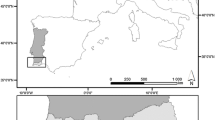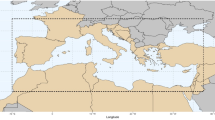Abstract
This paper presents ideas of random set modeling of fire spread, corresponding algorithms of model parameter estimation, and prediction of fire spread. Some facts indicating the stochastic nature of fire spread are reviewed. A brief survey of deterministic and stochastic models of spread and a description of random set models based on a Markov process called random spread process (RSP) is given. Random set models of local fire spread are considered in more detail. Results of a theory of estimation of RSP model parameters are used. Experimental and real fire data obtained by some Russian research institutes and fire protection services are discussed. This paper shows how random set models of fire spread may be used in computer experiments of fire modeling. Also, a comparison between real and computer data is established. A summary is given of the software for protecting territory from fire, based on random set models of fire spread. Applications of the software for the simulation of forest and timber-yard fire spread under given weather conditions are presented. Supporting theories of set-means and of random set models of spread and computational aspects are in the Appendix. Finally, a few references to the vast Russian literature on modeling of fire spread are given.
Similar content being viewed by others
References
Anderson, D. H., Catchpole, E. A., DeMestre, N. J., and Parkes, T., “Modeling the Spread of Grassland Fires,”J. Austral. Math. Soc (Series B), 13 (1982), 452–466.
Green, D. G., “Shapes of Fires in Discrete Fuels,”Ecological Modeling 20 (1983), 21–32.
Green, D. G., Gill, A. M. and Noble, I. R., “Fire Shapes and the Adequacy of Spread Models,”Ecological Modeling 20 (1983), 33–45.
Kourtz, P. and O'Reagan, W., “A Model for a Small Forest Fire ⋯ to Simulate Burned and Burning Areas for Use in a Detection Model,” Forest Sci., 17 (1971), 163–169.
Richards, G. D., “An Elliptical Growth Model of Forest Fire Fronts and Its Numerical Solution,”Int. J. Numer. Methods Eng., 30 (1990), 1163–1179.
Richards, G. D., “Numerical Simulation of Forest Fires,”Int. J. Numer. Methods Eng. 25 (1988), 625–634.
Van Wagner, C. E., “A Simple Fire Growth Model,”Forestry Chron. 45 (1969), 103–104.
Dorrer, G. A., “Estimation of Statistical Characteristics of Forest Fire Contours,”Physics of Combustion and Explosion, Russia: 2 (1978), 71–76.
Dorrer, G. A.,Mathematical Models of Forest Fire Dynamics. Moscow: Forest Industry, 1979.
“Forest Fires,”Scientific Siberian, A, 3, AMSE Press, 1992.
Zeldovich, Ya B., Barenblatt, G. I., Librovich, V. B., and Makhviladze, G. M.,Mathematical Theory of Combustion and Explosion Moscow: Nauka, 1980.
Stoyan, D., and Lippmann, G., “Models of Stochastic Geometry: A Survey,”ZOR—Methods and Models of Operation Research 38 (1993), 235–260.
Stoyan, D., Kendall, W. S., and Mecke, J.,Stochastic Geometry and Its Applications Berlin: Akademie-Verlag, Wiley, Chichester, 1987.
Cressie, N. and Hulting F. L., “A Spatial Statistical Analysis of Tumor Growth,”J. Amer. Stat. Assoc. 87 (1992), 272–283.
Tautu, P., “Stochastic Spatial Processes in Biology: A Concise Historical Survey,”In Stoch. Spat. Processes, ed. P. Tautu (Springer Lecture Notes in Mathematics), 1212 (1986), 1–41.
Richardson, D., “Random Growth in a Tesselation,”Math. Proc. Cambridge Phil. Soc. 74 (1973), 515–528.
Durrett, R., “Crabgrass, Measles and Gypsy Moth: An Introduction to Modern Probability,”Bull. Amer. Soc. 18 (1988), 117–143.
Durrett, R. and Liggett, T. M., “The Shape of the Limit Set in Richardson's Model,”Ann. Probab. 9 (1981), 186–193.
Liggett, T. M.,Interacting Particle Systems New York: Springer-Verlag, 1985.
Cox, J. T. and Durrett, R., “Limit Theorems for the Spread of Epidemics and Forest Fires,”Stochastic Process. Appl. 30 (1988), 171–191.
Durrett, R., and Liu, X. F., “The Contact Processes on a Finite Set,”Ann. Probab. 16 (1988), 1158–1173.
Vorob'ov, O. Yu., “Mathematical Description of Random Spread Processes and Its Control,”Izvestiya of SB of USSR Academy of Science 13 (1973), 145–152.
Vorob'ov O.Yu.,Average Measure Modeling Moscow: Nauka, 1984.
Vorob'ov, O. Yu., “Models of States of Some Distributed Probabilistic Processes,”Izvestiya of SB of USSR Academy of Science 8 (1976), 90–94.
Vorob'ov, O. Yu., “Methods of Modeling of Random Spread Processes,”Izvestiya of SB of USSR Academy of Science 3 (1976), 105–113.
Vorob'ov O. Yu., and Valendic, E. N.,Probabilistic Set Modeling of Forest Fire Spread Novosibirsk: Nauka, 1978.
Cressie, N.,Statistics for Spatial Data New York: J. Wiley & Sons, 1991.
Stoyan, D., and Stoyan H.,Fractals, Random Shapes, Point Fields J. Wiley: Chichester, 1994.
Rothermel, R. C., “How to Predict the Spread and Intensity of Range Fires,”USDA Forest Serv. Res. Pap., INT-43, 1983.
Rothermel, R. C., “Fire Spread Characteristics Determined in the Laboratory,”U.S. Forest Serv. Res. Pap. INT-30, 1966.
Rothermel, R. C., “A Mathematical Model for Predicting Fire Spread in Wildland Fuels,”U.S. Forest Serv. Res. Pap. INT-115, 1972.
Bazhenov, V. V., and Vorob'ov, O. Yu., “Peculiarities of Statistical Modeling of Random Spread Processes,”Izvestiya of SB of USSR Academy of Science 13 (1976), 78–83.
Bazhenov, V. V., and Vorob'ov, O. Yu., “Identification of Random Spread Processes,”Izvestiya of SB of USSR Academy of Science 9 (1978), 95–100.
Vorob'ov, O. Yu. and Vorob'ov, A. O., “Inverse Problems for Generalized Richardson's Model of Spread.” Manuscript, 1995.
Vorob'ov, O. Yu., “Set-Summation,”Soviet Math. Dokl. 43 (1991), 747–751, 1991.
Vorob'ov, O. Yu., “About Set-Characteristics of States of Distributed Probabilistic Processes,”Izvestiya of SB of USSR Academy of Science 3 (1977), 3–7.
Vorob'ov, O. Yu. and Stoyan, D., “Random Sets, Shapes, and Figures and Their Means,”Statistics of Compact Sets, Freiberg, TU Bergakademie, Preprint 94-04, 1994, 45–64.
Vorob'ov, O. Yu.,Advances in Modelling & Analysis, AMSE Press, 12 (1992), 1–46, and 16 (1993), 49–63.
Vorob'ov, O. Yu., “Calculus of Set-Distributions,”Doclady RAN 326 (1992), 583–588.
Vorob'ov, O. Yu., Set-Summation. Novosibirsk: Nauka, 1993, p. 137.
Vorob'ov, A. O., and Vorob'ov O. Yu., “Summation of Set-Additive Functions and Möbius Inversion,”Doclady RAN 335 (1994), 17–20.
Author information
Authors and Affiliations
Additional information
This research was supported by Deutsche Forschungsgemeinschaft, Bonn, 1993–94, N 436 RUS 17/47/93 (S) and partially supported by the Russian Fund of Fundamental Research, Moscow, 1995, N 95-01-01546a.
Rights and permissions
About this article
Cite this article
Vorob'ov, O.Y. Random set models of fire spread. Fire Technol 32, 137–173 (1996). https://doi.org/10.1007/BF01039896
Issue Date:
DOI: https://doi.org/10.1007/BF01039896




